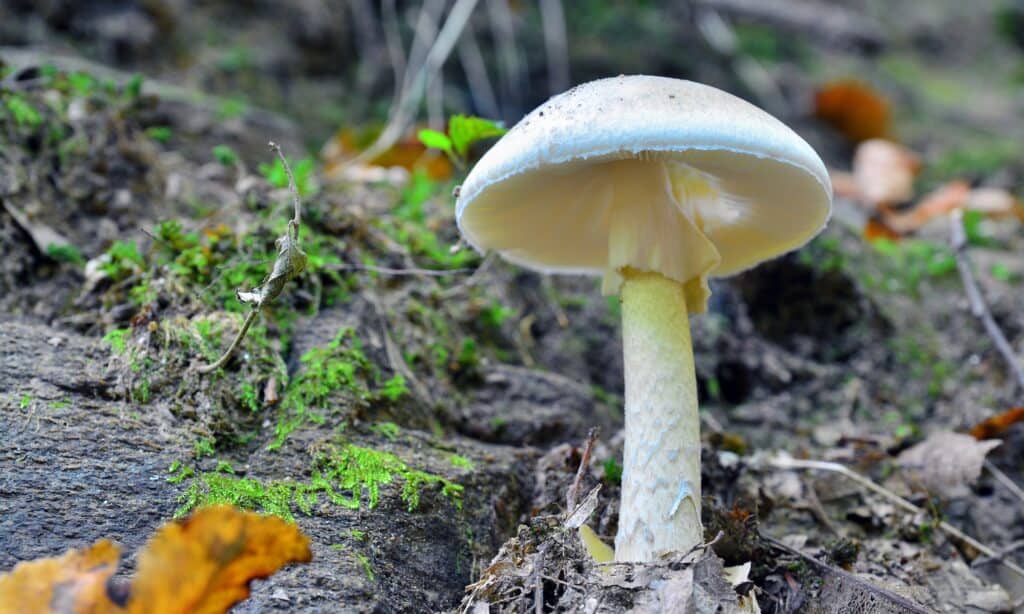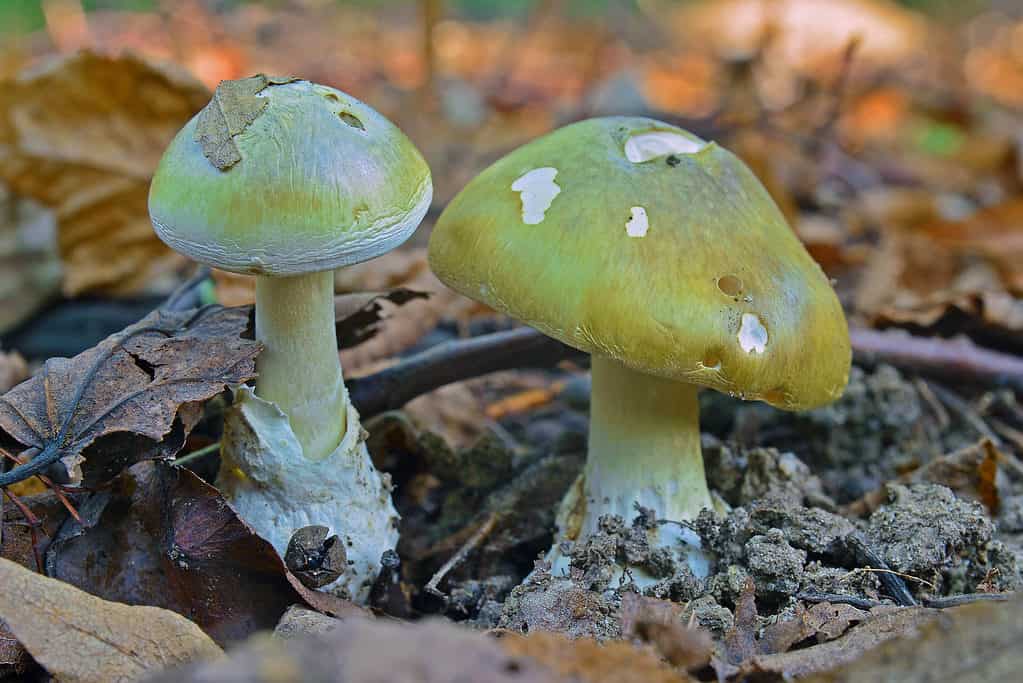The death cap mushroom is perhaps one of the most infamous of poisonous fungi, responsible for the majority of all mushroom-related deaths. So, what makes this mushroom so poisonous? How do you identify it? Where does it grow? We’ll cover all of this and more in our death cap mushroom guide.
So, without further ado, let’s jump in!
Death Cap Mushroom Classification
Commonly known as death cap, this deadly mushroom is botanically classified as Amanita phalloides. Belonging to the Amanita genus, the death cap is one of several well-known poisonous mushrooms in this genus. Other deadly Amanitas include the European destroying angels (Amanita virosa) and the Eastern North American destroying angel (Amanita bisporigera). The death cap mushroom belongs to the Amanitaceae family, which includes about 1,200 species.

The death cap mushroom is responsible for the majority of all mushroom-related deaths.
©iStock.com/empire331
Identifying The Death Cap Mushroom
As a member of the Amanita genus, death caps share similar features to many other Amanita species. Namely, it has pale gills that are free from the stipe, a universal veil, a long, slender stipe, a dry (not slimy) cap, and contains a saccate volva(a cup) at the base of the stipe.
Take Note of the Cap
Like other Amanita mushrooms, the cap of death caps morphs throughout its life cycle. When young, the cap will look spherical and you won’t be able to see the gills underneath it. As it grows, the cap expands outward until it has a flattened disc shape. You can see the gills underneath the cap of a mature Amanita phalloides. Typically, the cap color of this deadly mushroom is pale olive green-yellow or tan-light brown. At maturity, the cap is usually 4 to 6 inches across.

Amanita phalloides (death cap mushroom) is typically a pale olive green-yellow or tan-light brown in color.
©iStock.com/empire331
Description of Gills
So, if you think you’re looking at a death cap, take a look under the cap of a mature mushroom and look for the presence of white gills. The gills are responsible for dispersing the mushroom’s spores. They should look like fleshy slits that are crowded closely together and radiate outward from the center of the cap. However, on a death cap mushroom, the gills are not attached to the stipe. Rather, you should see a very thin ring around the stipe underneath the cap that separates the gills from the stipe. This is called a free gill attachment. You will see white gills with free gill attachment in most Amanita species.
On Death Cap, Look For a Universal Veil and Long, Slender Stipe
Depending on the developmental stage of the death cap mushroom, you should be able to see what is known as a “universal veil”. This veil is a membranous tissue that fully envelopes an immature mushroom, and separates as the fruiting body grows, leaving an egg-like structure around the base of the stipe, and a thin, membranous ring around the upper stipe. When the cap of the Amanita phalloides begins to expand and flatten, the universal veil breaks from the cap, and the gills are exposed, leaving a ringed remnant of the veil around the upper stipe.
You’ll notice that the stipe of a mature death cap is long, slender, white, and not hollow. It can grow up to 8 inches tall. You may notice a chalky, finely shaggy appearance on the stipe which is a remnant of the universal veil.

When the cap of the Amanita phalloides flattens, the universal veil breaks and the gills are exposed, leaving a ringed remnant of the veil.
©iStock.com/Igor Kramar
Check the Base of Death Cap’s Stipe
Another feature of the death cap is its white, egg-like structure enveloping the base of its stipe, called a saccate volva. This structure is remnants of the universal veil. If you think you’ve found a death cap mushroom, you can gently uncover the base of the fruiting body, and check for the presence of this structure.
Take a Spore Print
In addition to examining the physical features of the mushroom, you can also take a spore print to help verify the identity of a death cap mushroom. Since the color and texture of spores can vary based on mushroom species or family, taking a spore print can help you identify the mushroom in question.
So, to take a spore print, you’ll need to collect a mature sample of the species. Cut off the cap and place it with the gills facing downward on a dark piece of paper. It needs to be dark because the death cap, as well as all Amanitas, the spores are white, so if you use a white sheet of paper you won’t be able to see them clearly. Leave the cap in this position for at least 2 hours. Putting a bowl over the top of specimen can help. During this time, the gills should disperse the spores onto the sheet of paper. When you remove the cap you should see a beautiful gill-shaped ring of white spores on the paper.
Toxicity of Death Cap Mushrooms
Regarding its toxicity, the deadly chemical in Amanita phalloides, amatoxins, are responsible for over 90% of recorded mushroom-related human fatalities around the world. This toxin is also the poison present in other deadly amanitas such as destroying angels.
To counter a bit of the mycophobia present in many Western cultures, it’s important to note that an average of less than three people per year in the US are fatally poisoned by wild mushrooms. One study noted that out of 133,700 cases of mushroom poisoning over an 18-year period, only fifty-two fatalities occurred (2.9 average fatalities per year), with 86% of cases resulting in no to minor harm. In comparison to this number of fatalities, hundreds of thousands (if not millions) of people safely forage for a wide range of wild mushrooms across North America every year.
So, just how do amatoxins affect the human body? Primarily, amatoxins found in death caps attack the liver, which can result in acute liver damage or failure. This liver-attacking toxin is known as a hepatotoxin. Typically, symptoms of poisoning appear 6-12 hours after ingestion of the mushroom.
A lethal dose for an adult human can be as little as a mere 20 grams. The initial set of signs and symptoms include gastrointestinal pain, vomiting, nausea, profuse diarrhea, elevated heart rate, and dehydration. After this initial phase of symptoms, the poisoned person may appear to be recovering. However, in this phase which may last two to three days, liver damage continues to occur. Between days three to seven, acute liver failure and death can occur. If ingestion of a death cap mushroom is suspected, the person should immediately go to the ER for treatment and monitoring, as a liver transplant may be needed.

A death cap can also be identified by its white, egg-like structure enveloping the base of its stipe, called a volva.
©el_cigarrito/Shutterstock.com
Where Death Cap Mushrooms Grow and their Ecological Niche
While they originated in Europe, death cap mushrooms have since spread around the world and can be found growing in moist, shaded areas near oak, beech, chestnut, birch, hazelnut, pine trees and others. This species can be exported with its host trees(nut trees, pines, oaks, etc). In the US, death caps are especially abundant on the West Coast. Typically, these mushrooms develop mycorrhizal relationships with oak trees on the West Coast and pine trees on the East Coast. Mycorrhiza comes from the Greek words for “fungus” and “roots” and describes a beneficial relationship between a fungus and a plant. There have been some recent studies that suggest Amanita phalloides may be finding new ways to reproduce and spread.
As a mycorrhizal fungus, the expansive, underground portion of the death cap mushroom (the mycelium) branches out like a network of thin fibers and delivers nutrients to its host plant. In exchange, the host plant, typically oak or pine, delivers sugar to the mycelium, which it needs to produce its fruiting bodies and disperse its spores.
So, while Amanita phalloides is deadly to us humans, it’s important to remember that these beautiful mushrooms serve an important ecological niche and help our forests thrive by providing essential nutrients to their host trees. If you think you’ve spotted a death cap mushroom, admire its beauty, and thank it for its role in our environment’s health, but don’t even think about eating it!
Up Next
- Shiitake Mushrooms: A Complete Guide
- 15+ Different Types of Mushrooms, From the Edible to the Deadly
- 8 Different Types of Poisonous Mushrooms You Should Avoid
The photo featured at the top of this post is © iStock.com/syaber
The information presented on or through the Website is made available solely for general informational purposes. We do not warrant the accuracy, completeness, or usefulness of this information. Any reliance you place on such information is strictly at your own risk. We disclaim all liability and responsibility arising from any reliance placed on such materials by you or any other visitor to the Website, or by anyone who may be informed of any of its contents. None of the statements or claims on the Website should be taken as medical advice, health advice, or as confirmation that a plant, fungus, or other item is safe for consumption or will provide any health benefits. Anyone considering the health benefits of particular plant, fungus, or other item should first consult with a doctor or other medical professional. The statements made within this Website have not been evaluated by the Food and Drug Administration. These statements are not intended to diagnose, treat, cure or prevent any disease.
Sources
- Bay Area Mycological Society, Available here: http://bayareamushrooms.org/mushroommonth/amanita_phalloides.html
- Mushroom Expert, Available here: https://www.mushroomexpert.com/amanita_phalloides.html
- BC Medical Journal, Available here: https://bcmj.org/articles/worlds-most-poisonous-mushroom-amanita-phalloides-growing-bc
- Taylor & Francis Online, Available here: https://www.tandfonline.com/doi/abs/10.1080/00275514.2018.1479561?journalCode=umyc20
- National Library of Medicine, Available here: https://www.ncbi.nlm.nih.gov/books/NBK431052/
Thank you for reading! Have some feedback for us? Contact the AZ Animals editorial team.







